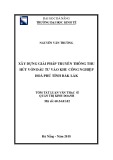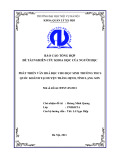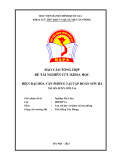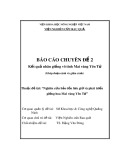
Gras and Kaul Retrovirology 2010, 7:30
http://www.retrovirology.com/content/7/1/30
Open Access
REVIEW
BioMed Central
© 2010 Gras and Kaul; licensee BioMed Central Ltd. This is an Open Access article distributed under the terms of the Creative Commons
Attribution License (http://creativecommons.org/licenses/by/2.0), which permits unrestricted use, distribution, and reproduction in
any medium, provided the original work is properly cited.
Review
Molecular mechanisms of neuroinvasion by
monocytes-macrophages in HIV-1 infection
Gabriel Gras*
1
and Marcus Kaul
2
Abstract
HIV associated neurocognitive disorders and their histopathological correlates largely depend on the continuous
seeding of the central nervous system with immune activated leukocytes, mainly monocytes/macrophages from the
periphery. The blood-brain-barrier plays a critical role in this never stopping neuroinvasion, although it appears
unaltered until the late stage of HIV encephalitis. HIV flux that moves toward the brain thus relies on hijacking and
exacerbating the physiological mechanisms that govern blood brain barrier crossing rather than barrier disruption. This
review will summarize the recent data describing neuroinvasion by HIV with a focus on the molecular mechanisms
involved.
Introduction
HIV-1 infection is often associated with neurocognitive
impairment and the various degrees of severity have
recently been categorized under the overarching term
HIV associated neurocognitive disorders (HAND) [1].
HAND defines three categories of clinical disorders
according to standardized measures of dysfunction: i)
asymptomatic neurocognitive impairment (ANI), ii) mild
neurocognitive disorder (MND) and iii) HIV-associated
dementia (HAD) [2].
HAD constitutes the most severe form of HAND [1]
which presented itself prominently at the beginning of
the AIDS epidemic but primarily in patients with low
CD4+ cell counts and advanced HIV disease [3]. Intro-
duction of combination anti-retroviral therapy (cART)/
highly active antiretroviral therapy (HAART) in the mid
1990 improved treatment of HIV infection and often pre-
vented or at least delayed the progression to AIDS and
HAD. In recent years, however, and since HIV patients
live longer, the incidence of dementia as an AIDS-defin-
ing illness has increased, and HAD now defines a signifi-
cant independent risk factor for death due to AIDS [4,5].
While in the HAART era MND appears to be more prev-
alent than frank dementia, it appears important to take
these long lasting disorders into account in patients' fol-
low up as they may profoundly affect quality of life, com-
plicate autonomy, modify treatment compliance and
induce a high level of vulnerability. Moreover, clinical
observations over more than 10 years also suggest that
HAART cannot completely protect from HAD [1,4-7]. In
addition, it is possible that life-long treatment with
HAART itself generates a toxicological problem which
may affect neurocognitive performance on its own [5,8].
The neuropathological correlates of HIV-1 infection
are generally referred to as HIV encephalitis (HIVE) and
comprise microglial nodules, activated resident micro-
glia, multinucleated giant cells, infiltration predomi-
nantly by monocytoid cells, including blood-derived
macrophages, widespread reactive astrocytosis, myelin
pallor, and decreased synaptic and dendritic density in
combination with distinct neuronal loss [9-11]. HIV-1
associated neuronal damage and loss have been reported
for numerous regions of the central nervous system
(CNS), including frontal cortex [12,13], substantia nigra
[14], cerebellum [15], and putamen [16].
The neuropathology of HIV infection and AIDS has
changed under the influence of HAART [6,7,17]. Neu-
roinflammation was commonly observed in HIV patients
at the beginning of the AIDS epidemic and before the
introduction of HAART, and usually increased through-
out the progression of infected individuals from the
latent, asymptomatic stage of the disease to AIDS and
HAD [18]. Surprisingly, neuroinflammation seems to
persist or even flourish since the advent of HAART
[17,19]. Autopsy studies in recent years found microglial
activation comparable to that in fully developed AIDS
* Correspondence: gabriel.gras@cea.fr
1 Institute of Emerging Diseases and Innovative Therapies, Division of Immuno-
Virology, CEA, 18 Route du Panorama, F92265 Fontenay-aux Roses, France
Full list of author information is available at the end of the article

Gras and Kaul Retrovirology 2010, 7:30
http://www.retrovirology.com/content/7/1/30
Page 2 of 11
cases from the pre-HAART era, although the primary
sites of neuroinflammation are seemingly changed. Dur-
ing pre-HAART times a strong involvement of the basal
ganglia was observed whereas post-HAART specimen
displayed prominent signs of inflammation in the hip-
pocampus and adjacent parts of the entorhinal and tem-
poral cortex [17]. Interestingly, HAART appeared to limit
or even prevent lymphocyte infiltration into the CNS
with the exception of the occasionally occurring immune
reconstitution inflammatory syndrome (IRIS), that is
characterized by massive lymphocytosis, extensive demy-
elination and white matter damage [6,17].
HIV-1 enters the brain early in the course of infection,
presumably via infected macrophages and lymphocytes,
and then persists primarily in perivascular macrophages
and microglia [11,20,21]. The pathophysiological rele-
vance of CNS invading lymphocytes in HAND remains to
be established [22], but CD8+ T cells have been suggested
to control intrathecal HIV replication [23]. In contrast to
lymphocytes, an increased number of microglia and mac-
rophages correlates well with the severity of pre-mortem
HAND [11,18,24].
Infection of the CNS by HIV-1 can be detected and
monitored by measurement of viral RNA in cerebrospinal
fluid (CSF). Several groups have reported a positive cor-
relation between CSF viral load and the observed degree
of cognitive dysfunction in patients with HAND [25-27].
Moreover, CSF viral load appears to correlate with viral
load in brain measured by quantitative PCR [27,28], and
the highest concentrations of virus are observed in those
subcortical structures most frequently affected in
patients with severe HAND/HAD [28].
However, in addition to initial neuroinvasion and infec-
tion of perivascular macrophages and microglia, factors
associated with progressive HIV infection in the periph-
ery, thus outside the brain, may be required to eventually
trigger the development of HAND and dementia [29].
One such factor could be an elevated number of circulat-
ing monocytes expressing two markers of activated
monocytes, CD16 and CD69. Another important player
may be the blood brain barrier (BBB) which separates the
CNS from the periphery and supposedly controls the
traffic of low-molecular-weight nutrients, peptides, pro-
teins and cells in and out of the brain (see for BBB review
[30]). Thus the condition of the BBB may potentially
determine continuing or repeated neuroinvasion during
the course of HIV disease. However, the molecular mech-
anisms underlying HIV neuroinvasion are only slowly
emerging. This review will discuss recent progress in
studies of cellular and molecular factors affecting HIV
neuroinvasion and consequent neurocognitive sequelae.
Peripheral Factors Influencing HIV-1 Neuroinvasion
While interferons (IFNs) are important for an anti-viral
immune response, the lasting production of IFN-α and -γ
in HIV-1 infection has been linked to an erroneous and
exhaustive immune activation leading eventually to
immune suppression and progression to AIDS [31-33]. In
addition, the sustained presence of IFN-α in the HIV-
infected CNS correlates with neurocognitive impairment
[34,35]. Therefore, IFNs appear to have indeed a major
impact on the overall course of HIV disease and conse-
quently also on the development of HAND. However, it is
not well understood whether or not IFNs directly influ-
ence neuroinvasion of HIV-1. One possible effect may be
the IFN-induced expression in the human BBB of
APOBEC3G, which has been suggested to account for the
limited ability of human brain microvascular endothelial
cells (HBMEC) to support HIV-1 replication and thus
dissemination into the central nervous system [36].
Peripherally circulating, activated CD16+CD69+
monocytes are prone to adhere to normal endothelium of
the brain microvasculature; they transmigrate and might
subsequently trigger a number of deleterious processes
[29]. Moreover, CD16+ monocytes become an expanding
immune cell population during HIV infection [37], par-
ticularly with progression to AIDS [38]. These CD16+
monocytes are also more susceptible to HIV infection
than the CD16- subset and are the major HIV reservoir
among monocytes in vivo [39,40]. In fact, CD16+ mono-
cytes likely serve as a vector for HIV trafficking from the
periphery into the brain [29,41]. Indeed, although most
monocytes do not actively replicate the virus, the mac-
rophages that differentiate from these infected mono-
cytes likely produce large amounts of virus after they quit
the circulation, considering that differentiated mac-
rophages are more prone to replicating HIV than mono-
cytes [42-48]. Furthermore, CD16+ monocytes/
macrophages can support HIV replication in T-lympho-
cytes [49] and may be sequestered by tissues expressing
the δ-chemokine Fractalkine (Fkn/CX3CL1), which
include the brain besides lymph nodes and intestine [50-
52]. These activated monocytes that represent a latent
provirus reservoir in the blood [40] thus may continu-
ously re-seed the brain with infected macrophages and
microglia. In addition, macrophages and microglia do
replicate HIV in the brain [11,20,21,53] and are not sus-
ceptible to the virus' cytopathic effects [54,55] thus per-
mitting them to produce virions throughout their long
life span [56-58].
In both HIVE and simian immunodeficiency virus
encephalitis (SIVE), CD163+/CD16+ macrophages are
detected in the parenchyma of the brain and seem to rep-
resent the primary productively infected cell population
[53]. The elevated number of CD163+/CD16+ monocytes/
macrophages may reflect an alteration of peripheral
mononuclear cell homeostasis and is associated with
increased viral burden and reduction of CD4+ T cells. In
SIV infection increased viral burden is associated with
development of encephalitis, and suggests that the

Gras and Kaul Retrovirology 2010, 7:30
http://www.retrovirology.com/content/7/1/30
Page 3 of 11
CD163+/CD16+ monocyte/macrophage subset may be
important in HIV/SIV-associated CNS disease [53]. The
critical role of macrophages in the HIV-infected brain is
further supported by the viral coreceptor usage. CCR5 is
the main coreceptor for HIV infection of macrophages
and microglia [59-61], and most virus isolates found in
the brain or the CSF use CCR5 [60,62-68]. Of note, the
very rare brain-derived R5X4 isolates exhibit tissue spe-
cific changes in the V3 region of gp120 that increase the
efficiency of CCR5 usage and enhance their tropism for
macrophages and microglia [69]. Moreover, macrophage
tropism rather than R5 tropism appears to predict neu-
rotropism [67], further emphasizing the role of these cells
in NeuroAIDS.
One recent study used fluorescein-positive monocytes
in acute simian immunodeficiency virus infection to
track neuroinvasion [70]. In this study employing rhesus
macaques, fluorescein dye-labeled autologous leukocytes
were introduced in the periphery from where the cells
subsequently entered into the choroid plexus stromata
and perivascular locations in the cerebra during acute
SIV infection. The infiltrated cells displayed both CD16
and CD68, both markers for macrophages and microglia.
The neuroinvasion of monocytes occurred simultane-
ously with detectable amounts of virus in CNS tissue and
CSF. Furthermore, neuroinvasion was accompanied by
the appearance of the proinflammatory chemokines
CXCL9/MIG and CCL2/MCP-1 in the brain. Interest-
ingly, before neuroinvasion became obvious, plasma viral
load peaked; counts of peripheral blood monocytes rap-
idly increased; and circulating monocytes displayed an
elevated capacity to generate CCL2/MCP-1. Acute infil-
tration of monocytes into the brain is thus central in early
neuroinvasion in the SIV animal model of AIDS. Besides
a prominent role of migratory monocytes for SIV/HIV
neuroinvasion, this study suggested that a disturbance
occurs at the barriers between blood and brain paren-
chyma as well as blood and CSF [70].
As an alternative to HIV entry via infected mac-
rophages, it has been suggested that the inflammatory
cytokine TNF-α promotes a para-cellular route for the
virus across the BBB [71]. However, in a study in the
feline immunodeficiency virus model, cell-free FIV
crossed the BBB only in very low quantities [72]. More-
over, the presence of TNF-α did not change viral transfer
or compromise BBB integrity. In contrast, FIV readily
crossed the BBB when cell-associated, yet without any
significant impairment of the BBB. In response to TNF-α,
the migratory activity of uninfected and infected lympho-
cytes increased in association with an up-regulation of
vascular endothelial adhesion molecule (VCAM)-1 and
some detectable disturbance of the BBB. Interestingly,
once infected cells and TNF-α were introduced on the
abluminal side of the BBB in the brain parenchyma, an
additional enhanced cell infiltration and more pro-
nounced disruption of the BBB ensued. Moreover, the
same study concluded that CNS invasion of lymphocyte-
tropic lentiviruses is essentially very similar to that of
macrophage-tropic strains [72].
HIV-1 infection compromises the structural integrity of
the intestinal tract and can cause leakage of bacteria into
the blood stream. Such microbial translocation results in
elevated plasma levels of bacterial lipopolysaccharide
(LPS), and in HIV-infected/AIDS patients, is associated
with increased monocyte activation and dementia [73-
75]. Another study suggests that HIV infection increases
the vulnerability of the BBB in response to LPS and facili-
tates the transmigration of peripheral monocytes/mac-
rophages [76]. These findings support an important role
for Toll-like receptors (TLRs) besides monocytes and
macrophages in HAD [75,76].
On the part of the host, a vicious cycle of immune dys-
regulation and BBB dysfunction might be required to
achieve sufficient entry of infected or activated immune
cells into the brain to cause neuronal injury [77,78]. On
the side of the virus, variations of the envelope protein
gp120 might also influence the timing and extent of
events allowing viral entry into the CNS and leading to
neuronal injury [79].
Blood-Brain-Barrier (BBB)
The BBB is widely believed to play an important role in
HIV infection of the CNS [29,80]. For example, an acute
relapsing brain edema with diffuse BBB alterations and
axonal damage was observed early during the AIDS epi-
demic [81]; and the extravasation of plasma protein
through an altered BBB has long been described in AIDS
and HIVE cases [82]. In vivo, increased permeability of
the BBB following HIV/SIV neuroinvasion is associated
with the disorganization of tight junctions [83]. In partic-
ular zonula occludens (ZO-1) expression is modified in
brains of patients with HIV encephalitis [71,84], and loss
of occludin and claudin-5 correlates with areas of mono-
cytes infiltration [85]. Such modifications of molecules
involved in BBB structure are also found in the brain of
SIV-infected macaques with SIVE [86,87]. Nevertheless,
these profound modifications of the BBB structure
appear to be late events associated with encephalitis
whereas neuroinvasion is an early and continuing pro-
cess.
Regarding the underlying molecular mechanisms
involved in BBB crossing by HIV, it appears appropriate
to consider in particular the following processes: HIV-
dependent cytotoxicity towards cellular BBB compo-
nents, chemotaxis, regulation of adhesion molecules and
tight junction proteins, and last not least the potential
influence of drugs of abuse.

Gras and Kaul Retrovirology 2010, 7:30
http://www.retrovirology.com/content/7/1/30
Page 4 of 11
Cytotoxicity Towards Cellular BBB Components
The HIV envelope protein gp120 apparently can trigger
cytotoxicity in human brain microvascular endothelial
cells (HBMEC) [88]. The process required the presence of
IFN-γ and activation of the p38 mitogen-activated pro-
tein kinase (MAPK). Interestingly, gp120-induced cyto-
toxicity occurred only in HBMEC from children but not
from adults. The treatment with IFN-γ resulted in an up-
regulation of the chemokine receptors CCR3 and CCR5
in HBMECs which in turn may have enhanced the toxic
interaction with the viral envelope protein [88].
Interestingly, alterations in the BBB occur even in the
absence of intact virus in transgenic mice expressing the
HIV envelope protein gp120 in a form that circulates in
plasma [89]. This finding suggests that circulating virus
or envelope proteins may provoke BBB dysfunction at
least during the viremic phase of primary infection.
Chemotaxis
Neurons, astrocytes and microglia all produce chemok-
ines - cell migration/chemotaxis inducing cytokines -
such as monocyte chemoattractant protein CCL2/MCP-1
and CX3CL1/Fkn, which appear to attract peripheral
blood mononuclear cells (PBMC) across the BBB into the
brain parenchyma [22,90].
In fact, an increased risk of HAD has recently been
connected to a mutant MCP-1 allele that causes
increased infiltration of mononuclear phagocytes into tis-
sues [91]. In HIV/SIV infection, macrophages/microglia
and astrocytes express increased quantities of MCP-1/
CCL2 [92-94], a chemokine that efficiently attracts
monocytes across the BBB. Numerous cell types, includ-
ing macrophages/microglia, astrocytes and endothelial
cells, produce MCP-1 in response to inflammatory stimu-
lation [95]. Of note, HIV infection of macrophages
increased their expression of the CCL2 receptor, CCR2,
and CCL2 mediated transmigration of HIV-infected
PBMC reduced tight junction proteins occludin, claudin-
1 and ZO-1 expression in a BBB model in vitro [94]. Stud-
ies by numerous groups suggested CCL2 in the CNS as a
key molecule for HIV encephalitis [96-100] during which
it accumulates in the CSF and brain parenchyma [97,101].
Macaques with SIVE behave similarly [100,102,103]. Of
importance in HIV infection [96] as well as in the SIV
model [100] is that the CCL2 concentration rises in the
CSF before neurological signs of the disease occur, con-
ferring to the concentration of CCL2 a potentially prog-
nostic value.
In a mouse model of HIVE based on animals with
severe combined immunodeficiency (HIVE-SCID
model), HIV-infected microglia and astrocytes seemed to
regulate monocyte migration across the BBB via the
release of β-chemokines [104]. On the other hand,
stromal cell-derived factor (SDF)-1/CXCL12, an α-
chemokine, has also been found to influence migration of
monocytes by regulating attachment of the cells to
HBMEC via the β2 integrin lymphocyte function-associ-
ated antigen (LFA)-1 in a Lyn kinase dependent fashion
[105]. CXCL12 is up-regulated in neuroinflammatory
diseases such as HAND/HAD or multiple sclerosis, and
the same study found that the α-chemokine concomi-
tantly reduced monocyte adherence to intercellular adhe-
sion molecule (ICAM)-1, which binds β2 integrins.
Interestingly, CXCL12 also counteracted the effect of
TNF-α, IL-1β and HIV gp120 regarding an increase of
monocyte attachment to HBMEC due to an up-regula-
tion of ICAM-1 [105]. In line with these observations and
important for the better understanding of HIV-CNS dis-
ease, we found that nerve growth factor (NGF) promotes
the attraction of monocytes by CXCL12 with a preferen-
tial effect on the CD16+ subset [106], while at the same
time decreasing HIV-1 replication in the attracted and
infected cells [107], suggesting a specific attraction of
uninfected monocytes.
Using an in vitro model of the BBB comprised of
endothelial cells and astrocytes, another study found that
both CXCL12 and CCL2 promoted transmigration of
uninfected monocytes and lymphocytes [108]. This
investigation also revealed that HIV-1 transactivator of
transcription (Tat) induced adhesion molecules and
chemokines in astrocytes and microglia which may fur-
ther increase the trafficking of PBMC into the brain. At
the cellular level of monocytes and macrophages, the pro-
migratory effect of CCL2 appears to involve K+ channels
[109].
A recent microarray study of HBMEC co-cultured with
HIV-infected macrophages found the induction of
numerous pro-inflammatory and IFN-inducible genes in
comparison to endothelial cells exposed to uninfected
immune cells [110]. In a separate investigation by the
same group, HIVgp120 was observed to trigger in
HBMEC the activation of signal transducer and activator
of transcription (STAT)-1 and the release of interleukin
(IL)-6 and IL-8 [111]. The eukaryotic interleukins and the
viral gp120 promoted, in an in vitro BBB model, the
attachment and transmigration of monocytes; and those
processes were prevented by inhibitors of MAPKs, phos-
phatidyl-inositol 3 kinase (PI3K) or STAT-1 [111]. Fur-
thermore, the pro-inflammatory and IFN-inducible gene
products released by HBMEC upon exposure to HIV-1
have been found to down-regulate the expression of tight
junction proteins claudin-5, ZO-1, and ZO-2 [112]. Inter-
estingly, an increase of active STAT1 and a reduction of
claudin-5 were also found in microvessels of brain speci-
mens from HAD patients [112]. Of note, the HIV-1 enve-
lope protein gp120 seems to be able to trigger many of the
effects leading to a compromised BBB and enhanced
monocyte transmigration [113].

Gras and Kaul Retrovirology 2010, 7:30
http://www.retrovirology.com/content/7/1/30
Page 5 of 11
In line with the altered gene expression of HBMEC
exposed to HIV-1 infected macrophages, a proteomic
study found that over 200 proteins were up-regulated
under the same conditions [114]. The affected cellular
components included metabolic pathways, ion channels,
cytoskeletal, heat-shock, calcium-binding and transport-
related proteins.
Translocation of bacterial LPS from the intestine in
HIV-1 infection may not only promote the capability of
peripheral monocytes to transmigrate into the brain, but
may also encounter a BBB weakened by the effects of a
systemic lentiviral infection. In a transgenic mouse
model, JR-CSF/EYFP mice, expressing both a long termi-
nal repeat-regulated full-length infectious HIV-1 provirus
(JR-CSF) and a ROSA-26-regulated enhanced yellow flu-
orescent protein (EYFP) as transgenes, peripheral mono-
cytes had an increased capability to enter the brain
through an intact or partially compromised BBB [76].
Partial impairment of the BBB was induced by systemic
LPS. Importantly, the BBB of JR-CSF/EYFP mice seemed
more susceptible to disturbance by LPS than the BBB of
HIV-1 free control animals. An earlier in vitro study by
others found that placing LPS-stimulated macrophages
on an artificial BBB led to the occurrence of gaps between
endothelial cells and caused a significant increase in
monocyte transmigration [115]. The activated mono-
cytes released TNF-α, IL-6 and IL-10, but viral infection
itself surprisingly did not increase transmigration under
these conditions, suggesting that the LPS exerted a domi-
nant effect. A more recent study found an alternate
mechanism where LPS enhanced the trans-cellular trans-
port of HIV-1 across the BBB via a p38 MAPK-dependent
pathway [116].
Tryptophan metabolism via the kynurenine pathway
occurs in the human BBB during HIV-1 infection and has
been linked to immune tolerance and neurotoxicity [117].
Endothelial cells and pericytes of the BBB, as well as
astrocytes [118], acquire upon immune stimulation the
capability to produce kynurenine, which when released
into the vicinity of macrophages and microglia could be
further metabolized to the neurotoxin quinolinic acid
[119]. Of note, IFNs and LPS are both able to activate
tryptophan catabolism in macrophages [120], a process
that may add to the effects of BBB activation during HIV
infection. Thus, peripheral HIV-1 infection and associ-
ated immune stimulation side by side with LPS transloca-
tion could potentially exert neurotoxicity across the BBB
even without the virus entering the brain.
Adhesion Molecules
Cell migration also engages adhesion molecules, and
increased expression of various adhesion molecules, such
as VCAM-1, has been implicated in mononuclear cell
migration into the brain during HIV and SIV infection
[80,115,121,122]. Astrocytes apparently control expres-
sion of ICAM-1 in endothelial cells of the BBB, and upon
exposure to TNF-α, produce themselves ICAM-1,
VCAM-1, IG9 and E-selectin, all of which may promote
monocyte attachment and transmigration [121].
HIV-infected macrophages, in particular when addi-
tionally stimulated with LPS, induce expression of E-
selectin and VCAM-1 in brain microvascular endothelial
cells (BMEC) [80]. In brain specimens from AIDS
patients with HIVE, detection of E-selectin and VCAM-1
correlated with HIV-1 and pro-inflammatory cytokines;
and an association of invading macrophages and
increased signal for endothelial adhesion molecules were
observed in HIVE samples.
Possibly counteracting the effects of pro-inflammatory
cytokines, the activation of peroxisome proliferator-acti-
vated receptor γ (PPARγ) in HBMECs can suppress the
activity of Rho GTPases (Rac1 and RhoA) and inhibit
adhesion and transendothelial migration of HIV-1
infected monocytes [123].
Tight Junction Proteins
Concomitant with the development of HIVE, the expres-
sion of tight junction proteins between BMECs of the
BBB decreases. The disruption of tight junctions between
BMECs is apparently mediated through the activation of
focal adhesion kinase (FAK) by phosphorylation at TYR-
397 [124]. Furthermore, HIV-1 gp120 seems capable of
inducing the disruption of tight junctions by triggering
proteasomal degradation of ZO-1 and ZO-2 in HBMEC
[125]. Interestingly, the scaffolding protein 14-3-3tau
appears to counteract the down-regulation by HIV gp120
of ZO-1 and ZO-2; and even more surprisingly, the viral
envelope protein specifically increases expression of 14-
3-3tau [125].
In addition to HIV gp120, Tat also affects tight junction
proteins [126]. As such Tat reduces the expression of
occludin, ZO-1, and ZO-2 in the caveolar compartment
of HBMECs. The effect of Tat is dependent on caveolin-1
and its modulation of Ras signaling.
Drugs of Abuse and Alcohol
Abuse of psycho-stimulatory and addictive drugs seems
to increase the risk of HIV-1 infection and of the develop-
ment of HAND [127-130].
HIV Tat and morphine apparently cooperate in dimin-
ishing the electrical resistance and increasing the trans-
migration across the BBB via the activation of pro-
inflammatory cytokines, the stimulation of intracellular
Ca2+ release, and the activation of myosin light chain
kinase [131]. A similar effect is caused by both metham-
phetamine and HIV gp120 either alone or in combination
[132].
Cocaine also alters the expression of tight junction pro-
teins and induces stress fibers in BMECs, and it in addi-
tion up-regulates the pro-migratory CCL2/CCR2 ligand-




![PET/CT trong ung thư phổi: Báo cáo [Năm]](https://cdn.tailieu.vn/images/document/thumbnail/2024/20240705/sanhobien01/135x160/8121720150427.jpg)





















